Tianyi Zhao
Credence Calibration Game? Calibrating Large Language Models through Structured Play
Aug 20, 2025Abstract:As Large Language Models (LLMs) are increasingly deployed in decision-critical domains, it becomes essential to ensure that their confidence estimates faithfully correspond to their actual correctness. Existing calibration methods have primarily focused on post-hoc adjustments or auxiliary model training; however, many of these approaches necessitate additional supervision or parameter updates. In this work, we propose a novel prompt-based calibration framework inspired by the Credence Calibration Game. Our method establishes a structured interaction loop wherein LLMs receive feedback based on the alignment of their predicted confidence with correctness. Through feedback-driven prompting and natural language summaries of prior performance, our framework dynamically improves model calibration. Extensive experiments across models and game configurations demonstrate consistent improvements in evaluation metrics. Our results highlight the potential of game-based prompting as an effective strategy for LLM calibration. Code and data are available at https://anonymous.4open.science/r/LLM-Calibration/.
NS-FPN: Improving Infrared Small Target Detection and Segmentation from Noise Suppression Perspective
Aug 09, 2025Abstract:Infrared small target detection and segmentation (IRSTDS) is a critical yet challenging task in defense and civilian applications, owing to the dim, shapeless appearance of targets and severe background clutter. Recent CNN-based methods have achieved promising target perception results, but they only focus on enhancing feature representation to offset the impact of noise, which results in the increased false alarms problem. In this paper, through analyzing the problem from the frequency domain, we pioneer in improving performance from noise suppression perspective and propose a novel noise-suppression feature pyramid network (NS-FPN), which integrates a low-frequency guided feature purification (LFP) module and a spiral-aware feature sampling (SFS) module into the original FPN structure. The LFP module suppresses the noise features by purifying high-frequency components to achieve feature enhancement devoid of noise interference, while the SFS module further adopts spiral sampling to fuse target-relevant features in feature fusion process. Our NS-FPN is designed to be lightweight yet effective and can be easily plugged into existing IRSTDS frameworks. Extensive experiments on the public IRSTDS datasets demonstrate that our method significantly reduces false alarms and achieves superior performance on IRSTDS tasks.
Rethinking Multi-modal Object Detection from the Perspective of Mono-Modality Feature Learning
Mar 14, 2025Abstract:Multi-Modal Object Detection (MMOD), due to its stronger adaptability to various complex environments, has been widely applied in various applications. Extensive research is dedicated to the RGB-IR object detection, primarily focusing on how to integrate complementary features from RGB-IR modalities. However, they neglect the mono-modality insufficient learning problem that the decreased feature extraction capability in multi-modal joint learning. This leads to an unreasonable but prevalent phenomenon--Fusion Degradation, which hinders the performance improvement of the MMOD model. Motivated by this, in this paper, we introduce linear probing evaluation to the multi-modal detectors and rethink the multi-modal object detection task from the mono-modality learning perspective. Therefore, we construct an novel framework called M$^2$D-LIF, which consists of the Mono-Modality Distillation (M$^2$D) method and the Local Illumination-aware Fusion (LIF) module. The M$^2$D-LIF framework facilitates the sufficient learning of mono-modality during multi-modal joint training and explores a lightweight yet effective feature fusion manner to achieve superior object detection performance. Extensive experiments conducted on three MMOD datasets demonstrate that our M$^2$D-LIF effectively mitigates the Fusion Degradation phenomenon and outperforms the previous SOTA detectors.
Conformalized Link Prediction on Graph Neural Networks
Jun 26, 2024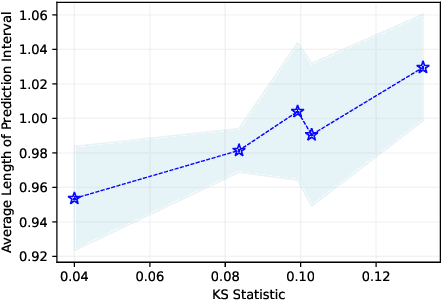


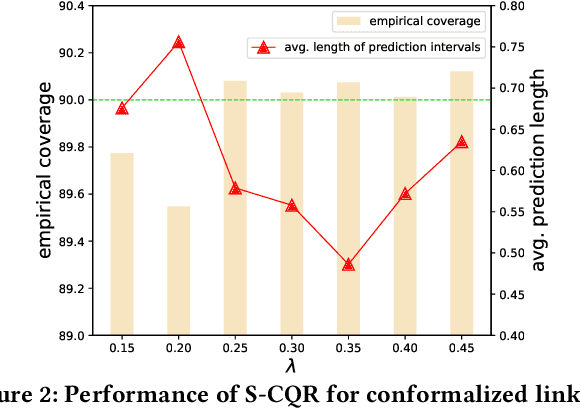
Abstract:Graph Neural Networks (GNNs) excel in diverse tasks, yet their applications in high-stakes domains are often hampered by unreliable predictions. Although numerous uncertainty quantification methods have been proposed to address this limitation, they often lack \textit{rigorous} uncertainty estimates. This work makes the first attempt to introduce a distribution-free and model-agnostic uncertainty quantification approach to construct a predictive interval with a statistical guarantee for GNN-based link prediction. We term it as \textit{conformalized link prediction.} Our approach builds upon conformal prediction (CP), a framework that promises to construct statistically robust prediction sets or intervals. We first theoretically and empirically establish a permutation invariance condition for the application of CP in link prediction tasks, along with an exact test-time coverage. Leveraging the important structural information in graphs, we then identify a novel and crucial connection between a graph's adherence to the power law distribution and the efficiency of CP. This insight leads to the development of a simple yet effective sampling-based method to align the graph structure with a power law distribution prior to the standard CP procedure. Extensive experiments demonstrate that for conformalized link prediction, our approach achieves the desired marginal coverage while significantly improving the efficiency of CP compared to baseline methods.
UniRGB-IR: A Unified Framework for Visible-Infrared Downstream Tasks via Adapter Tuning
Apr 26, 2024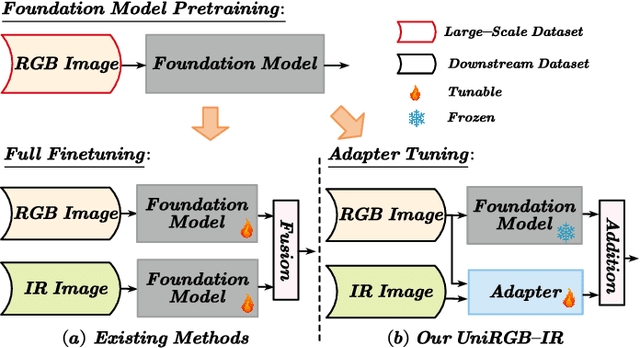

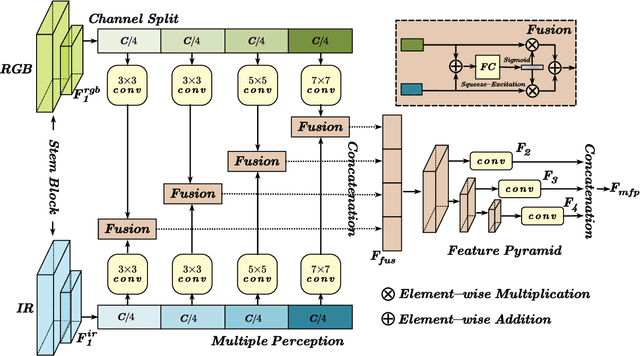
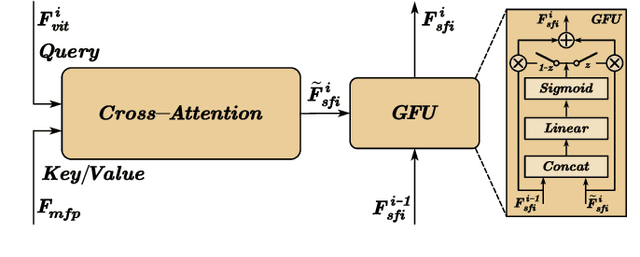
Abstract:Semantic analysis on visible (RGB) and infrared (IR) images has gained attention for its ability to be more accurate and robust under low-illumination and complex weather conditions. Due to the lack of pre-trained foundation models on the large-scale infrared image datasets, existing methods prefer to design task-specific frameworks and directly fine-tune them with pre-trained foundation models on their RGB-IR semantic relevance datasets, which results in poor scalability and limited generalization. In this work, we propose a scalable and efficient framework called UniRGB-IR to unify RGB-IR downstream tasks, in which a novel adapter is developed to efficiently introduce richer RGB-IR features into the pre-trained RGB-based foundation model. Specifically, our framework consists of a vision transformer (ViT) foundation model, a Multi-modal Feature Pool (MFP) module and a Supplementary Feature Injector (SFI) module. The MFP and SFI modules cooperate with each other as an adpater to effectively complement the ViT features with the contextual multi-scale features. During training process, we freeze the entire foundation model to inherit prior knowledge and only optimize the MFP and SFI modules. Furthermore, to verify the effectiveness of our framework, we utilize the ViT-Base as the pre-trained foundation model to perform extensive experiments. Experimental results on various RGB-IR downstream tasks demonstrate that our method can achieve state-of-the-art performance. The source code and results are available at https://github.com/PoTsui99/UniRGB-IR.git.
A Survey on Safe Multi-Modal Learning System
Feb 08, 2024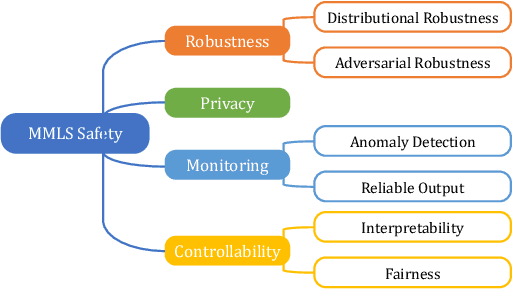
Abstract:With the wide deployment of multimodal learning systems (MMLS) in real-world scenarios, safety concerns have become increasingly prominent. The absence of systematic research into their safety is a significant barrier to progress in this field. To bridge the gap, we present the first taxonomy for MMLS safety, identifying four essential pillars of these concerns. Leveraging this taxonomy, we conduct in-depth reviews for each pillar, highlighting key limitations based on the current state of development. Finally, we pinpoint unique challenges in MMLS safety and provide potential directions for future research.
Removal and Selection: Improving RGB-Infrared Object Detection via Coarse-to-Fine Fusion
Jan 19, 2024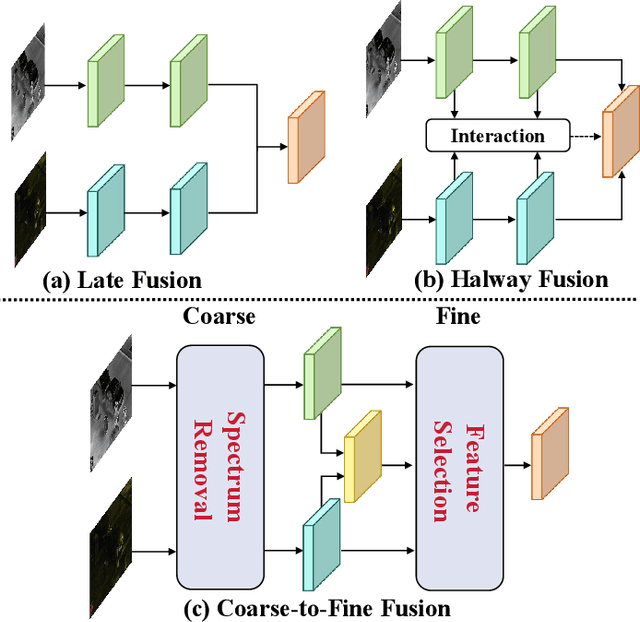



Abstract:Object detection in visible (RGB) and infrared (IR) images has been widely applied in recent years. Leveraging the complementary characteristics of RGB and IR images, the object detector provides reliable and robust object localization from day to night. Existing fusion strategies directly inject RGB and IR images into convolution neural networks, leading to inferior detection performance. Since the RGB and IR features have modality-specific noise, these strategies will worsen the fused features along with the propagation. Inspired by the mechanism of human brain processing multimodal information, this work introduces a new coarse-to-fine perspective to purify and fuse two modality features. Specifically, following this perspective, we design a Redundant Spectrum Removal module to coarsely remove interfering information within each modality and a Dynamic Feature Selection module to finely select the desired features for feature fusion. To verify the effectiveness of the coarse-to-fine fusion strategy, we construct a new object detector called Removal and Selection Detector (RSDet). Extensive experiments on three RGB-IR object detection datasets verify the superior performance of our method.
Unveiling the Role of Message Passing in Dual-Privacy Preservation on GNNs
Aug 25, 2023

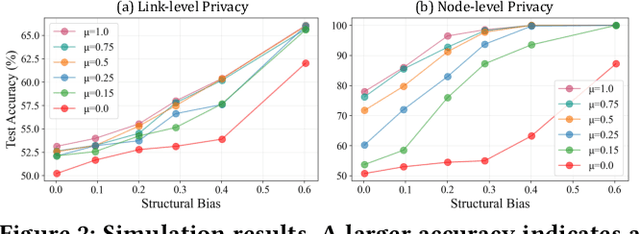
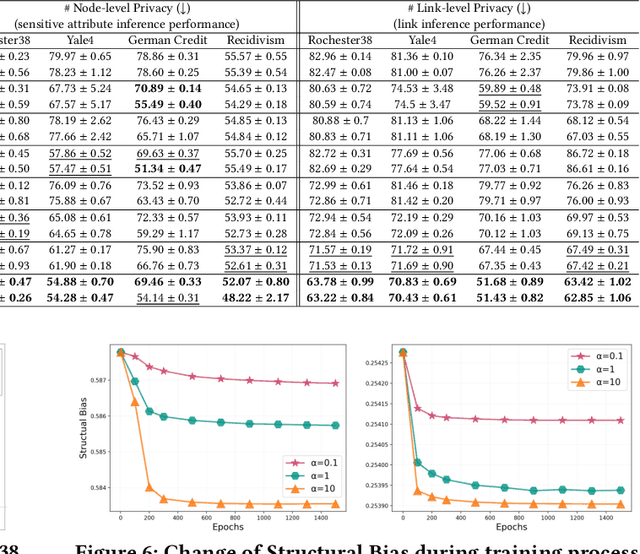
Abstract:Graph Neural Networks (GNNs) are powerful tools for learning representations on graphs, such as social networks. However, their vulnerability to privacy inference attacks restricts their practicality, especially in high-stake domains. To address this issue, privacy-preserving GNNs have been proposed, focusing on preserving node and/or link privacy. This work takes a step back and investigates how GNNs contribute to privacy leakage. Through theoretical analysis and simulations, we identify message passing under structural bias as the core component that allows GNNs to \textit{propagate} and \textit{amplify} privacy leakage. Building upon these findings, we propose a principled privacy-preserving GNN framework that effectively safeguards both node and link privacy, referred to as dual-privacy preservation. The framework comprises three major modules: a Sensitive Information Obfuscation Module that removes sensitive information from node embeddings, a Dynamic Structure Debiasing Module that dynamically corrects the structural bias, and an Adversarial Learning Module that optimizes the privacy-utility trade-off. Experimental results on four benchmark datasets validate the effectiveness of the proposed model in protecting both node and link privacy while preserving high utility for downstream tasks, such as node classification.
Learning to Pan-sharpening with Memories of Spatial Details
Jun 28, 2023
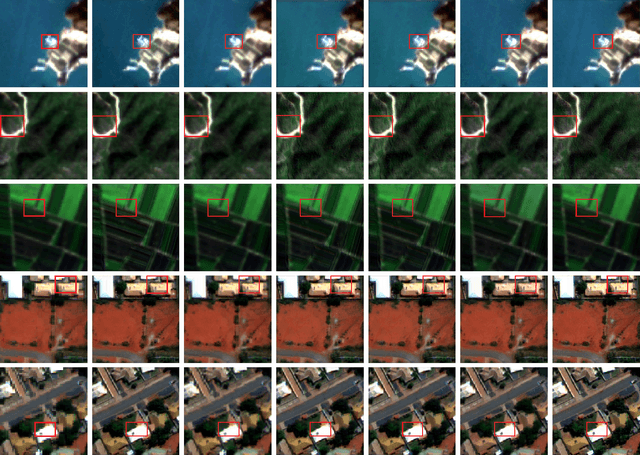


Abstract:Pan-sharpening, as one of the most commonly used techniques in remote sensing systems, aims to inject spatial details from panchromatic images into multi-spectral images to obtain high-resolution MS images. Since deep learning has received widespread attention because of its powerful fitting ability and efficient feature extraction, a variety of pan-sharpening methods have been proposed to achieve remarkable performance. However, current pan-sharpening methods usually require the paired PAN and MS images as the input, which limits their usage in some scenarios. To address this issue, in this paper, we observe that the spatial details from PAN images are mainly high-frequency cues, i.e., the edges reflect the contour of input PAN images. This motivates us to develop a PAN-agnostic representation to store some base edges, so as to compose the contour for the corresponding PAN image via them. As a result, we can perform the pan-sharpening task with only the MS image when inference. To this end, a memory-based network is adapted to extract and memorize the spatial details during the training phase and is used to replace the process of obtaining spatial information from PAN images when inference, which is called Memory-based Spatial Details Network (MSDN). We finally integrate the proposed MSDN module into the existing DL-based pan-sharpening methods to achieve an end-to-end pan-sharpening network. With extensive experiments on the Gaofen1 and WorldView-4 satellites, we verify that our method constructs good spatial details without PAN images and achieves the best performance. The code is available at https://github.com/Zhao-Tian-yi/Learning-to-Pan-sharpening-with-Memories-of-Spatial-Details.git.
GAN-RXA: A Practical Scalable Solution to Receiver-Agnostic Transmitter Fingerprinting
Mar 25, 2023Abstract:Radio frequency fingerprinting has been proposed for device identification. However, experimental studies also demonstrated its sensitivity to deployment changes. Recent works have addressed channel impacts by developing robust algorithms accounting for time and location variability, but the impacts of receiver impairments on transmitter fingerprints are yet to be solved. In this work, we investigat the receiver-agnostic transmitter fingerprinting problem, and propose a novel two-stage supervised learning framework (RXA) to address it. In the first stage, our approach calibrates a receiver-agnostic transmitter feature-extractor. We also propose two deep-learning approaches (SD-RXA and GAN-RXA) in this first stage to improve the receiver-agnostic property of the RXA framework. In the second stage, the calibrated feature-extractor is utilized to train a transmitter classifier with only one receiver. We evaluate the proposed approaches on transmitter identification problem using a large-scale WiFi dataset. We show that when a trained transmitter-classifier is deployed on new receivers, the RXA framework can improve the classification accuracy by 19.5%, and the outlier detection rate by 10.0% compared to a naive approach without calibration. Moreover, GAN-RXA can further increase the closed-set classification accuracy by 5.0%, and the outlier detection rate by 7.5% compared to the RXA approach.
 Add to Chrome
Add to Chrome Add to Firefox
Add to Firefox Add to Edge
Add to Edge